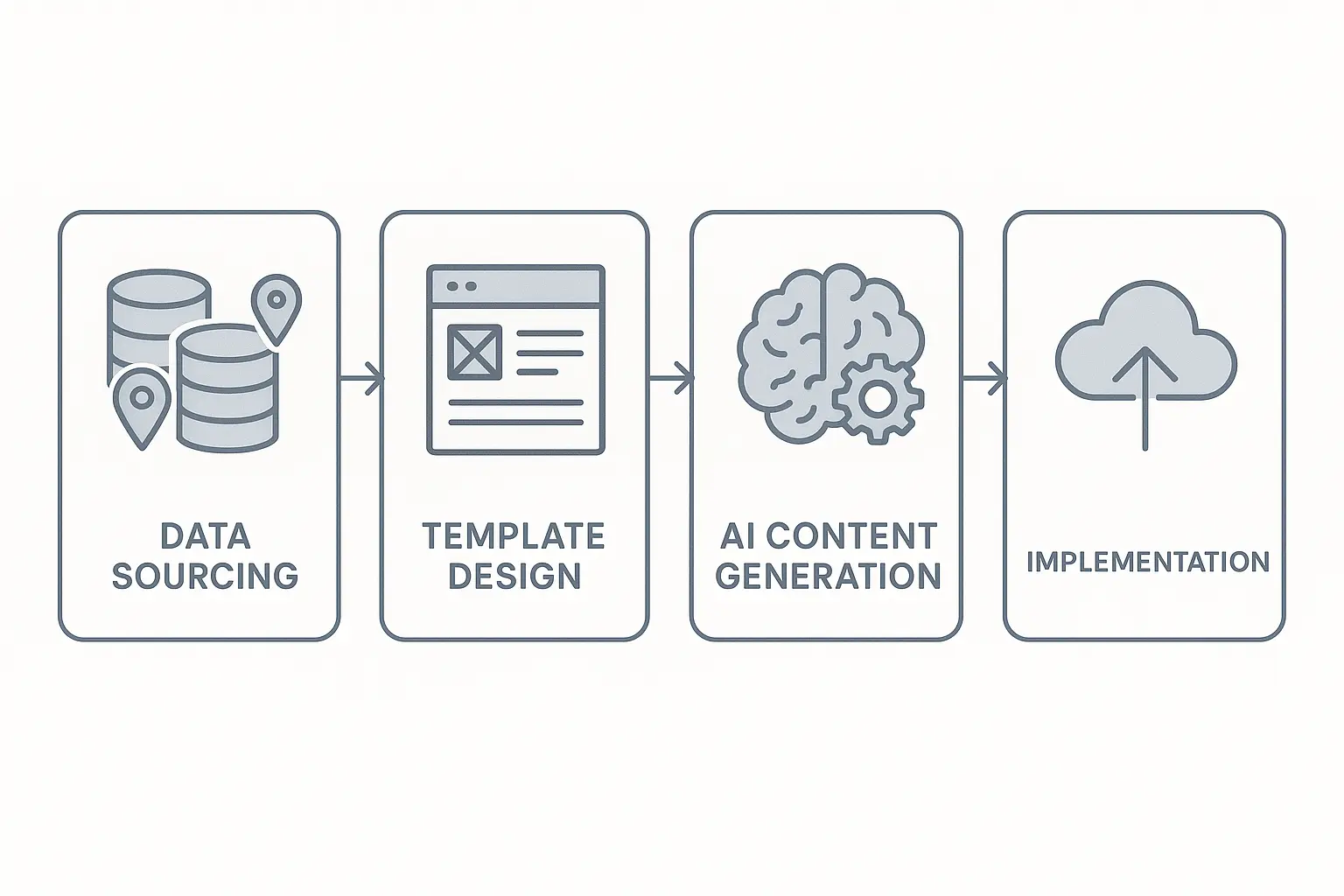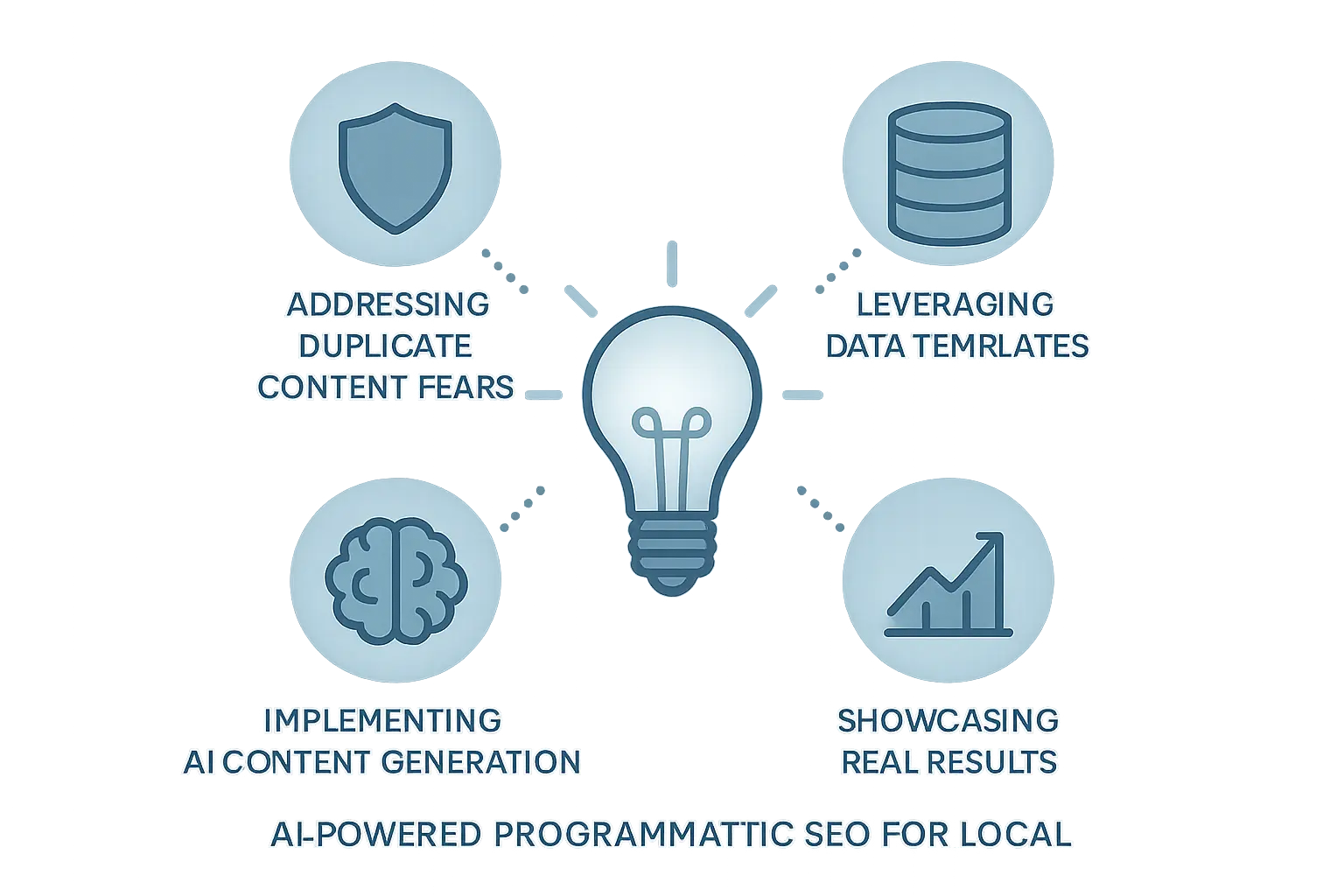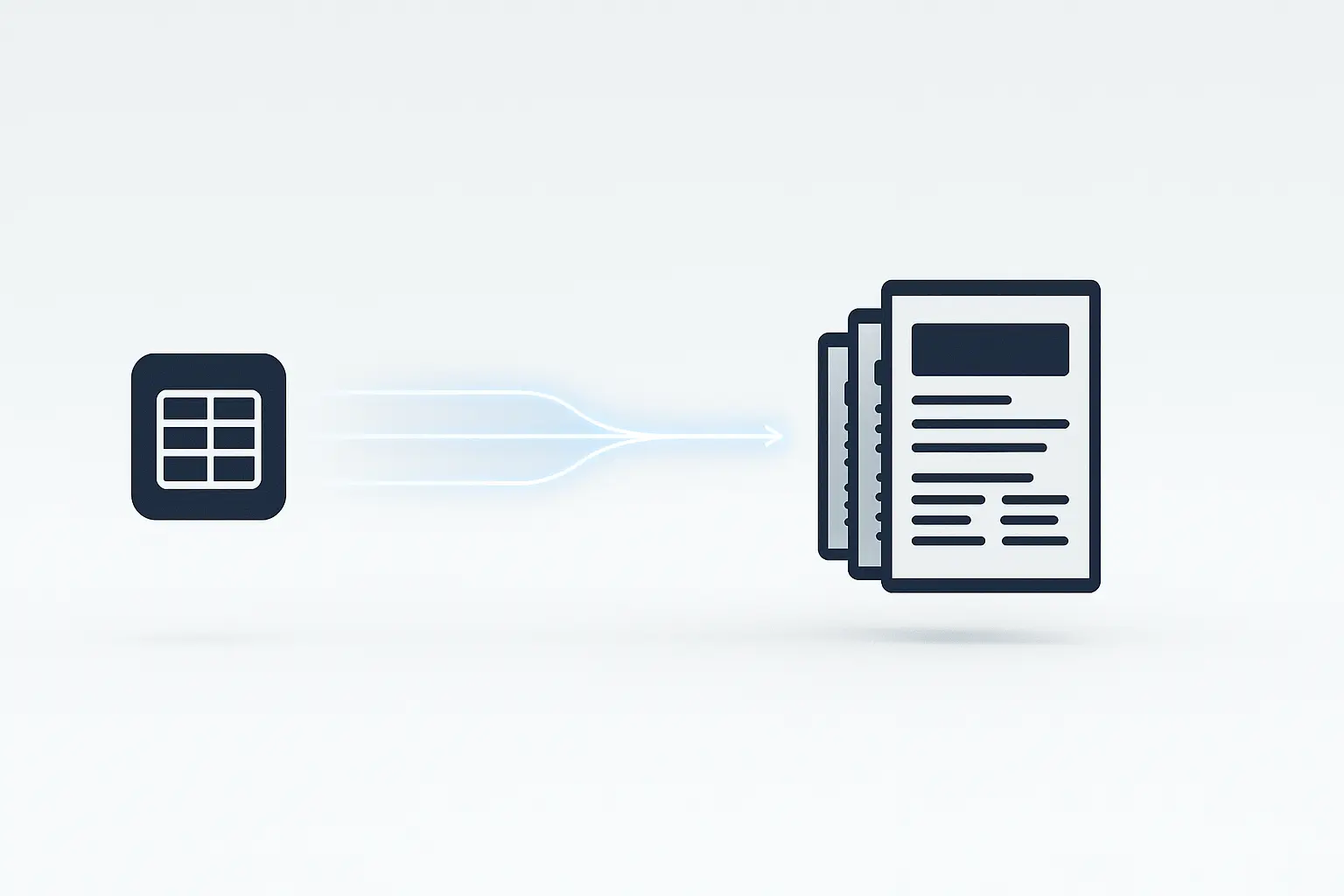Imagine your client, a successful roofing company, wants to dominate search results in every single suburb of Chicago. Not just the city center, but Naperville, Evanston, Schaumburg, and all fifty other towns in their service area.
Manually creating a unique, optimized page for “roof repair in Naperville,” “roof repair in Evanston,” and so on would take a content writer weeks, if not months.
Now, what if you could create all of those pages—each one unique and optimized—in a single afternoon?
This isn’t a far-fetched fantasy. It’s the reality of AI-powered Programmatic SEO (pSEO). For agencies with service-based clients, mastering this workflow is what separates linear growth from exponential scale. With “near me” searches growing by over 200% in recent years, failing to capture hyperlocal intent is like leaving money on the table in hundreds of neighborhoods at once.
What is Programmatic SEO, Really?
Let’s clear something up. When people hear “programmatic,” they sometimes think of low-quality, spammy content. That’s the old way. Modern Programmatic SEO is about using data and templates to create high-quality, valuable pages at scale.
Think of it like a mail merge for your website. You have:
-
A Data Source: A structured list of variables, like cities, services, or zip codes.
-
A Template: A master page design with placeholders for those variables.
Programmatic SEO then combines the data with the template to automatically generate a unique page for every entry in your data source. When supercharged with AI, this process moves beyond simple text replacement to create genuinely useful and nuanced content for each location.
The Old Way: Why Manual Local Page Creation Breaks Down
For any agency that’s tried, building local landing pages one by one is a classic bottleneck. The process is riddled with challenges:
-
Incredibly Time-Consuming: Researching and writing dozens of pages is a massive drain on resources.
-
Prone to Errors: Creating pages by hand invites inconsistencies in branding, messaging, and on-page SEO.
-
Impossible to Update: If a client updates their phone number or adds a service, do you really want to edit 100 separate pages?
-
Unprofitable at Scale: The manual effort required makes it difficult to price competitively while protecting your margins.
This manual grind is precisely the problem an automated, programmatic approach solves. Companies using AI for these content tasks often report a 30-40% increase in efficiency.
The AI-Powered Programmatic Workflow: A Step-by-Step Guide
Ready to see how it works? Here’s a practical workflow for generating hundreds of optimized local service pages.
Step 1: Build Your Data Foundation
Your entire project rests on the quality of your data, which serves as your single source of truth. At a minimum, your database (which can be as simple as a Google Sheet or CSV file) should include columns for every variable you want to use.
For a local service business, this might include:
- City Name
- State
- Zip Code
- Neighborhood (if applicable)
- County
- Service Offered (e.g., “Emergency Plumbing,” “Drain Cleaning”)
- A unique local selling proposition (e.g., “Serving the North Shore for 20+ years”)
- A local testimonial or case study snippet
The more unique, high-quality data points you have, the more valuable and distinct each generated page will be.
Step 2: Engineer the Perfect Page Template
This is where you design the master blueprint for all your future pages. It’s a standard webpage layout, but instead of static text, you use placeholders that your data source will populate.
Your template should include placeholders for essential on-page SEO elements:
-
SEO Title: {{Service}} in {{City}}, {{State}} | Your Client’s Brand
-
Meta Description: Need expert {{Service}} in {{City}}? Our team has served the {{County}} area for over a decade. Call today for a free estimate!
-
H1 Heading: Trusted {{Service}} in {{City}}, {{State}}
-
Body Content: Weave variables naturally into the text. For instance: “For residents of {{City}}, finding a reliable provider for {{Service}} can be a challenge. That’s why we’re proud to offer our full range of services to the {{Zip Code}} area and beyond.”
The goal is to create a template that feels custom-written and locally relevant once the data is inserted.
Step 3: Unleash AI for Content Generation and Variation
Here’s where the magic happens. Instead of just plugging in variables, you can use AI to generate unique content for each page based on your data.
For example, you can prompt an AI model to:
-
“Write a 100-word introduction about the importance of {{Service}} for homeowners in {{City}}, mentioning the local landmark {{Landmark}}.”
-
“Generate a unique FAQ section about {{Service}} tailored to the common concerns of people in {{State}}.”
-
“Rephrase {{USP1}} and {{USP2}} into a compelling paragraph about our commitment to the community.”
This AI-driven step is crucial for avoiding duplicate content penalties and creating pages that provide genuine value. It’s the perfect blend of automation for scale and human-led strategy for quality.
Step 4: Generation, Optimization, and Internal Linking
With your data and template ready, you can use a script, a CMS plugin (like WordPress with ACF), or a dedicated platform to generate the pages. The system then populates the template with each row from your spreadsheet to automatically generate the pages.
Once the pages are live, the final step is to ensure they are properly linked internally. A common approach is to create a main “Service Areas” page that links out to every generated location page. This helps Google discover and index your new pages while distributing link equity throughout the site.

The Payoff: Unlocking Massive Local Visibility
The power of this strategy comes down to simple math and user behavior. A staggering 46% of all Google searches have local intent. When someone in a specific suburb searches for “emergency roofer near me,” they expect a result that speaks directly to their location. A generic “Chicago” page feels far less relevant than a page dedicated to “Emergency Roofing in Naperville.”
By creating these hyper-specific pages, you can perfectly match user intent at scale. The impact on the bottom line is undeniable—78% of local mobile searches result in an offline purchase. Capturing that traffic isn’t just an SEO win; it’s a direct driver of revenue for your client. For some businesses, programmatic SEO has led to a 10x increase in organic traffic by systematically capturing this long-tail, high-intent search demand.

Beyond the Basics: Weaving pSEO into a Broader Strategy
Programmatic SEO isn’t a silver bullet. These pages still need to be part of a holistic SEO plan. They require:
-
A technically sound website to live on.
-
A strong backlink profile to give them authority.
-
Optimized Google Business Profiles for each service area to reinforce local signals.
This is where a broader omnichannel strategy comes in, ensuring your programmatic content works in harmony with your client’s paid, social, and local search efforts. For agencies looking to add this advanced capability without the massive overhead of building an in-house team, white-label SEO partnerships offer a path to scaling service delivery.

Frequently Asked Questions (FAQ)
Is this considered spam by Google?
No, as long as it’s done correctly. The key is value. If your pages provide unique, useful, and location-specific information, Google sees them as valuable assets. Spam involves creating low-value, deceptive pages—the exact opposite of this strategy’s goal.
What’s the difference between this and “doorway pages”?
Doorway pages are thin pages created only to funnel users to a single destination, offering little unique value themselves. A well-executed programmatic page is a final destination, providing all the relevant information a user in that specific location needs.
How much unique content is needed per page?
Focus on unique value, not arbitrary word counts. A page with a location-specific map, a local testimonial, unique office hours, and content that mentions local neighborhoods is far more valuable than a page with 500 words of generic, rehashed text.
What tools do I need to get started?
The core components are a data source (like Google Sheets), a CMS that supports dynamic content (like WordPress), and a way to connect them. This can be done with plugins, custom scripts (Python is popular), or no-code tools like Zapier.
Your Next Step in Scalable SEO
AI-powered programmatic SEO transforms local SEO from a manual, time-intensive chore into a scalable growth engine for your agency and your clients. By systemizing the creation of high-value local pages, you can deliver results that were once impossible to achieve profitably.
Ready to put this theory into practice? If you’re an agency looking to build this capability, a clear roadmap is essential. Contact us to explore how a tailored automation strategy can fit into your growth plan and scale your client results.

